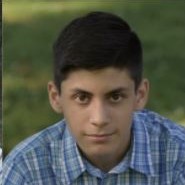Andres Nunez
Andres Nuñez - Class of 2022

Summer of 2020
Andres Nuñez helped in the search for a more effective treatment for breast cancer by weighing antibody fragments.
This was key to the efforts to develop treatments that do a better job of targeting the cancerous cells while leaving healthy cells intact. Determining the weight of the antibody fragments helps to affirm that they have been broken down to the correct size to attach to the cancer killing medications in a way that will target only the cancerous cells.
But weighing the fragments requires a special method. Called gel electrophoresis, it involves adding an electrical charge to the cells and then observing how far the fragments move through a porous gel.
Nuñez examined the results and found that the weights confirmed what was expected.
“They do seem to be consistent, which suggests that the fragmentation was a success,” he said. “If this technique were to be perfected in the future, this could mean a lot when it comes to treating other types of cancer as well.”
It was a fitting project for Nuñez, who has always been interested science, and focused specifically on biochemistry after reading a book about it. He found himself fascinated by “the little intricacies inside the body and how different things work and react with each other.”
Summer of 2021
When Andy Nuñez was in elementary school, he often found himself tuning the television to the Animal Planet channel — specifically the TV show “Monsters Inside Me.”
“The show sparked my interest in the human body and science as it dealt with parasites and their effects,” said Nuñez. “I have become far more interested in cancer research. Both my grandparents have battled cancer in the past, so this topic is very close to my heart.”
That interest led Nuñez into New Rochelle High School’s Science Research Program. Nuñez has been engaged in a project focused on making a molecule that would allow for the creation of a drug that kills only breast cancer cells.
Nuñez’s goal in synthesizing the molecule was to use it to create a viable drug that would treat HER2 positive breast cancer by killing only cancer cells while keeping healthy cells safe. To accomplish this, several reactions were completed.
To determine if the molecule was synthesized, a dye would become fluorescent. That would happen only if the molecule it was bound to also was synthesized. The molecule and dye would be mixed together and put into a fluorimeter to see if there was any light coming from the molecule.
While Nuñez’s study did not produce a properly synthesized molecule, he believes it is a step closer to finding the right formula, and he is eager to continue the work.
“My experience in this program is going to have a huge impact on me after high school,” he said. “After doing research for four years, I am extremely excited to continue this in college. I plan on entering either cancer research or neurotrauma research at whatever college I go to.”
